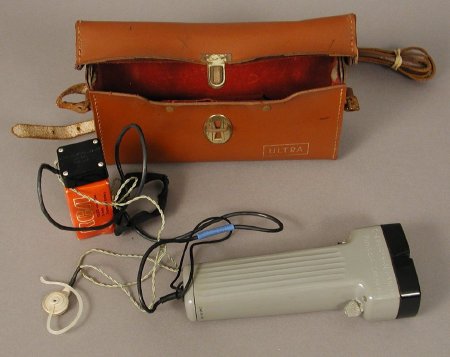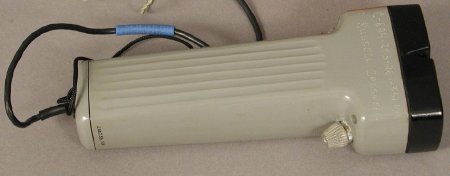Object ID:
2007.33.10
Title:
Kay Ultra "Torch"
Creator:
Kay, Leslie
Description:
(a) "Torch" ETA; gray plastic case resembling a square body flashlight; sides of body have raised lines for better grip; wider at head with two round aluminum screen fittings in black plastic surround which houses the unit's audio transmitter(bottom) and receiver (top); momentary contact switch on top of the head switches range of unit from 0-7' to 0-20'; rotary switch under head turns unit on/off and adjusts audio output volume; on rear of handle is black wrist strap, wire to black plastic junction box which fits onto battery and houses the earpiece; earpiece is pink plastic with removable plastic earclip, twisted gray insulated wire; engraved in side, "C-624-293-261-351 MO./RUSSELL CROSWELL; on sleeve on power wire, "UK PAT No. 978741"; (b) artificial russet leather case, fiberboard body with plastic covering, real leather shoulder strap riveted to sides with rubber shoulder pad; stitched and riveted construction; rectangular with hinged lid and push button brass plated latch; lined with thin red felt, internal battery compartment; in gold foil on front, "ULTRA"; (c) 9V transister battery from "RCA" in red cardboard housing, price tag on side, $2.50.
Dimensions:
H-3 W-1.5 L-7 inches
Date:
ca. 1962
Made by:
Ultra Electronics Limited; Kay, Leslie
Place of Origin:
London, England
Provenance:
During the 1950s, Dr. Leslie Kay worked for the British Navy developing underwater sonar technology to find submerged objects like submarines and mines.
The Torch, named for the British name for a flashlight due to its physical resemblance to one, was invented by Kay at the University of Birmingham in the late 1950s and early 60s after developing an interest in using sonar's principles to create electronic travel aids for the blind. Along with a colleague, Donald Griffin, Kay studied how bats used widespread frequency sweeps to navigate rather than the pulsed tones used by earlier ETA's. Lightweight and portable, his Torch scanned the area where it was pointed and provided auditory feedback to the user. According to L.W. Farmer, the Torch was widely tested and commercially produced on a moderate scale, but was eventually unsuccessful because it was imperfect as a "primary" travel aid, and took up a free hand to operate when being used as a secondary ETA. This is an earlier model than 2007.33.12, powered by an external transistor battery. (The transistor battery was invented in the mid 1950s.)
The Torch, named for the British name for a flashlight due to its physical resemblance to one, was invented by Kay at the University of Birmingham in the late 1950s and early 60s after developing an interest in using sonar's principles to create electronic travel aids for the blind. Along with a colleague, Donald Griffin, Kay studied how bats used widespread frequency sweeps to navigate rather than the pulsed tones used by earlier ETA's. Lightweight and portable, his Torch scanned the area where it was pointed and provided auditory feedback to the user. According to L.W. Farmer, the Torch was widely tested and commercially produced on a moderate scale, but was eventually unsuccessful because it was imperfect as a "primary" travel aid, and took up a free hand to operate when being used as a secondary ETA. This is an earlier model than 2007.33.12, powered by an external transistor battery. (The transistor battery was invented in the mid 1950s.)
Credit Line:
Gift of Association for Education and Rehabilitation of the Blind and Visually Impaired

